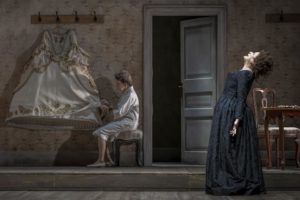
Opéra de Monte-Carlo 2022-23 Review: Alcina
Philippe Jaroussky & Cecilia Bartoli Shine in Masterful Production of Händel Masterpiece
By Robert Adelson & Jacqueline LetzterOn February 22nd, the Opéra de Monte-Carlo inaugurated a new era under the direction of Cecila Bartoli. To open her first season, Bartoli chose to present Handel’s 1735 opera seria “Alcina,” in which she stars in the title role.
“Alcina” has become one of the most frequently staged works by Händel. This past year alone has seen productions at Covent Garden, Opera North and the Glyndebourne Festival. The Monte-Carlo staging is the work of German stage director Christof Loy, in a co-production with the Zurich Opera.
Loy’s Transposition
Loy transposes the action from an enchanted island where the sorceress Alcina casts away her former lovers as animals, rivers or stones to an actual theater where the prima donna holds the hero Ruggiero just as captive as if she was an enchantress. Showing Alcina at times as a majestic and seductive prima donna and at times as a pitiful aging actress, Loy highlights the theme at the chore of Händel’s opera, the fragility of love and, even more poignantly, the transience of beauty.
Loy’s use of the theater as metaphor was underscored by the sets; most notably the curtain of Monte-Carlo’s Salle Garnier, which was transformed into a replica of the curtain of Stockholm’s Drottningholm palace theater. Since Ingmar Bergman’s 1975 film version of Mozart’s “The Magic Flute,” stage directors have paid homage to this architectural treasure, one of the few remaining eighteenth-century theaters preserved with its original stage machinery. Throughout the spectacle, the Drottningholm imagery served as a reminder of the theatrical milieu in Handel’s time.
The three acts take place in three different locations and at three different time periods. Act one is set in Handel’s time on and beneath the stage, with its wind and thunder machine (reproduced by the orchestra’s percussion section). Act two moves the action to the present, in the singers’ dressing rooms. In Act three, Alcina’s domain is an abandoned theater set of broken columns and porticos, representing the aging sorceress’s make-believe world that will be destroyed by the modern couple of Bradamante and Ruggiero.
Without detracting from Alcina’s central position in the drama, Loy emphasizes the role of Bradamante, determined to rescue her husband Ruggiero from Alcina’s spell. To accomplish this feat, Bradamante must disguise herself as a man, and in doing so attracts the amorous attention of Alcina’s sister Morgana and angers Morgana’s lover Oronte.
By coincidence, the neighboring Opéra de Nice was at the exact same time presenting Beethoven’s “Fidelio,” which also tells the story of a wife’s resolve to free her captive husband, which she must do by dressing as man and having to submit to the advances of another woman which incurs the jealous ire of the woman’s fiancé. Without insisting on these parallels between such very different works (Ruggiero is a prisoner of love and magic, whereas Florestan is a prisoner of conscience), one can nevertheless appreciate the similar theme of marital love as the driving force in a rescue, and in this way the iron-willed Bradamante of Loy’s production takes on a stature equivalent to that of Leonore.
Enriching this staging are the beautiful ballets choreographed by Thomas Wilhelm. Although for reasons of the opera’s length, Loy cut the ballet music, he inserted a short ballet in each act, thereby paying homage to the dancer and choreographer Marie Sallé (1709-1756) who had created the ballets for Handel’s Alcina. Loy also alludes to Marie Sallé in another more surprising way, through the non-speaking role of Cupido, interpreted by 84-year-old Katharine Sehnert. Sallé’s own performance as Cupido in a man’s costume in the ballets for Alcina caused her to be banned from the English stage in 1735.
The presence of a hovering angel or child is hardly a rarity in recent opera productions, but here it is used with remarkable efficacy. Sehnert, by her understated but sensitive acting, underscored the opera’s theme of fleeing beauty and marks the psychological evolution of the characters.
The Same but Different
In opera seria, the convention of the aria da capo with its formulaic repeat of the opening section is often seen as a formidable obstacle to audience’s appreciation. In the Monte-Carlo production one had the impression that the performers made a concerted effort to vary the da capo returns as much as possible, using all means at their disposal. In addition to the expected ornamentation of the vocal lines, tempos were also rendered exceptionally fluid, sometimes slowing to half speed, only to then push forward in an accelerando, and forte phrases were transformed in hushed prayers.
What was most unusual was that conductor Gianluca Capuano and his baroque orchestra Les Musiciens du Prince-Monaco joined the singers in this endeavor. The da capo sections of each aria were thus not only varied by the singers, but also by the orchestra. Rhythms were transformed from duple to triple, large intervals were filled in by rapid notes. In some arias, a tambourine was added, in others unusual instruments such as harp and organ joined the continuo group.
For the da capo in Alcina’s “Ombre pallide” in Act three, the strings played sul ponticello, with the bows close to the bridge to make a spooky ethereal sound, an effect rarely used before the nineteenth century. Since the string sections consist of several musicians playing the same part, this collective approach to embellishing da capo sections required writing out the ornaments ahead of time, as opposed to the singers who are free to improvise.
What was lost in spontaneity, however, was gained in variety, as the orchestra became an active partner in the psychological and musical evolution of each aria.
A Swan Song for Philippe Jaroussky?
This production marked Philippe Jaroussky’s first stage appearance at the Opéra de Monte-Carlo, but he has recently hinted that it could also be his last.
In an interview published just before the production, Jaroussky confided that this “Alcina” might be his farewell to baroque opera, as he envisions devoting his future career to conducting and singing contemporary music. If so, he would be leaving the baroque stage at the height of his artistry. Jaroussky’s Ruggiero was characterized by the character’s youth and gullibility, opening the production with a vacuous smile that showed him to be Alcina’s hopelessly brainwashed lover. Like the female characters, Alcina, Morgana and Bradamante, his Ruggiero questions himself and evolves as the opera progresses. Jaroussky excelled particularly in slow arias, where his singing was marked by an effortless phrasing and elegant trills. In his Act two aria “Mi lusinga il dolce affetto” the dotted rhythms and large ascending intervals that many other singers render with an angular rigidity were sung with impeccable smoothness.
Soprano Sandrine Piau sang the role of Alcina’s sister Morgana. Her Act two aria “Ama, sospira” was highly expressive, particularly in the da capo, where she treated the phrases with great flexibility of tempo. Her seamless legato in the Act three aria “Credete al mio dolore” was one of the most intense moments in the performance. Tenor Maxim Mironov’s light and clear timbre made for a convincing Oronte, and in his Act I aria “Semplicetto! a donna credi?”, his repeated high notes were refreshingly natural and unforced. The role of Melisso was ably performed with agile voice and inventive comic acting by bass-baritone Péter Kálmán.
The enhanced role of Bradamante was superbly performed by the Franco-Armenian mezzo-soprano Varduhi Abrahamyan, one of the singers recently chosen for Cecilia Bartoli’s label “Mentored by Bartoli.” Abrahamyan brought her character to the fore with vitality and occasional humor, resulting in a complexity and vigor that sometimes lacks in other productions. Among her many impressive vocal moments, her Act two aria “Vorrei vendicarmi” stood out for the long stretches of low-lying coloratura that are often a challenge for mezzos but which she sung with great aplomb.
Bartoli’s interpretation of the title role was masterful. She may no longer sing with the volume of her early years, but she commands a richer palette of vocal colors than almost any other artist in this repertoire. At the center of the spectacle was her famous Act two aria of despair “Ah! mio cor!”, which was so captivating it was almost an opera unto itself. In the second section of this aria, Bartoli proudly proclaims “Sono Regina!” (“I am the queen!”). In this spectacle, where she is not only the prima donna, but also the new Director of the Opéra de Monte-Carlo, this line took on added meaning.
If this “Alcina” is a harbinger of things to come, we can look forward to the spells this operatic sorceress will cast on future productions.



